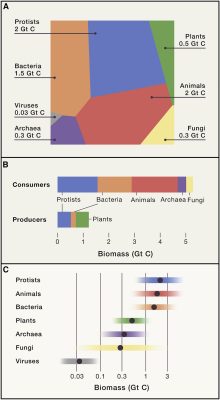3.2: Biomass of organisms living in the oceans
- Page ID
- 25876
\( \newcommand{\vecs}[1]{\overset { \scriptstyle \rightharpoonup} {\mathbf{#1}} } \)
\( \newcommand{\vecd}[1]{\overset{-\!-\!\rightharpoonup}{\vphantom{a}\smash {#1}}} \)
\( \newcommand{\id}{\mathrm{id}}\) \( \newcommand{\Span}{\mathrm{span}}\)
( \newcommand{\kernel}{\mathrm{null}\,}\) \( \newcommand{\range}{\mathrm{range}\,}\)
\( \newcommand{\RealPart}{\mathrm{Re}}\) \( \newcommand{\ImaginaryPart}{\mathrm{Im}}\)
\( \newcommand{\Argument}{\mathrm{Arg}}\) \( \newcommand{\norm}[1]{\| #1 \|}\)
\( \newcommand{\inner}[2]{\langle #1, #2 \rangle}\)
\( \newcommand{\Span}{\mathrm{span}}\)
\( \newcommand{\id}{\mathrm{id}}\)
\( \newcommand{\Span}{\mathrm{span}}\)
\( \newcommand{\kernel}{\mathrm{null}\,}\)
\( \newcommand{\range}{\mathrm{range}\,}\)
\( \newcommand{\RealPart}{\mathrm{Re}}\)
\( \newcommand{\ImaginaryPart}{\mathrm{Im}}\)
\( \newcommand{\Argument}{\mathrm{Arg}}\)
\( \newcommand{\norm}[1]{\| #1 \|}\)
\( \newcommand{\inner}[2]{\langle #1, #2 \rangle}\)
\( \newcommand{\Span}{\mathrm{span}}\) \( \newcommand{\AA}{\unicode[.8,0]{x212B}}\)
\( \newcommand{\vectorA}[1]{\vec{#1}} % arrow\)
\( \newcommand{\vectorAt}[1]{\vec{\text{#1}}} % arrow\)
\( \newcommand{\vectorB}[1]{\overset { \scriptstyle \rightharpoonup} {\mathbf{#1}} } \)
\( \newcommand{\vectorC}[1]{\textbf{#1}} \)
\( \newcommand{\vectorD}[1]{\overrightarrow{#1}} \)
\( \newcommand{\vectorDt}[1]{\overrightarrow{\text{#1}}} \)
\( \newcommand{\vectE}[1]{\overset{-\!-\!\rightharpoonup}{\vphantom{a}\smash{\mathbf {#1}}}} \)
\( \newcommand{\vecs}[1]{\overset { \scriptstyle \rightharpoonup} {\mathbf{#1}} } \)
\( \newcommand{\vecd}[1]{\overset{-\!-\!\rightharpoonup}{\vphantom{a}\smash {#1}}} \)
In the oceans (Figure 8), the biomass of living organisms decreases in the following order
- Animals, mainly represented by Crustacea (a sub-branch of the Arthropoda; mainly copepods, shrimps and krill) and fishes (mainly small fishes of the mesopelagic zone);
- Protists, both unicellular with, in particular, the Diatoms, Coccolithophorids and Dinoflagellates… and multicellular organisms with, essentially, the Phaeophyceae [27] (such as kelp and other brown algae);
- Bacteria, and in particular the cyanobacteria of the genera Prochlorococcus and Synechococcus whose biomass is estimated at ≈15% of the marine bacterial biomass;
- Plants (in the broad sense – the Archaeoplastids – including green and red algae [24] as well as flowering plants such as eelgrass or posidonia beds);
- Archaea, whose biomass corresponds to ≈20% of the marine bacterial biomass;
- Viruses, in particular phages, which play an important role in the recycling of nutrients during the lysis of marine bacteria (See focus Ocean viruses & The biological carbon pump of the oceans). While marine viruses outnumber bacteria and archaea by about an order of magnitude in various habitats [28], in terms of biomass in the ocean, they constitute only a tiny fraction, ≈1%, of the total biomass.
- Fungi, found both in the deep ocean and in coastal waters such as mangroves or low salinity estuaries.

Figure \(\PageIndex{1}\). Biomass of the oceans. A. Biomasses of each group of living things are represented using a Voronoi diagram, where the area of each surface is proportional to the biomass of the group of living organisms considered. B. Distribution of biomasses of different producer and consumer groups in ocean environments. C. Representation of the uncertainties as gradients around the values estimated in A. [Source: Baron and Milo, ref [5], License: CC-BY-SA]
The first three groups of this classification (Animals, protists and bacteria) represent alone nearly 80% of the oceanic biomass while they form only 2% of the continental biomass! Conversely, plants, which largely dominate terrestrial ecosystems by constituting more than 80% of the biomass, represent only a small fraction of the oceanic biomass (less than 10%). Moreover, two thirds of the oceanic biomass is made up of unicellular organisms.
In terms of habitat, the majority of marine biomass is planktonic (transported by ocean currents), a much smaller fraction belongs to {tooltip}necton{end-text}A set of marine organisms whose swimming ability is such that they can move against currents (fish, some crustaceans, cephalopods, and marine mammals).{Then there are the organisms attached to particles (attached to micro- or macro-aggregates in the open sea) and finally the organisms living on the sea floor (or benthic). This global representation varies according to the kingdom. Thus, macroalgae can be both benthic and planktonic (for example, the common genus of brown algae Sargassum). In contrast, most plant biomass is benthic and not planktonic. However, this distribution must take into account the large uncertainties associated with the analyses (see Focus on How to estimate the global biomass?) and the fact that the global biomass of the many hot spots on the ocean floor (submarine canyons for example) is still largely unknown.
By providing a better understanding of the structure of ocean ecosystems and their biomass, this study allows us to better parameterize the carbon stock of these environments. This is an important element for climate models.

